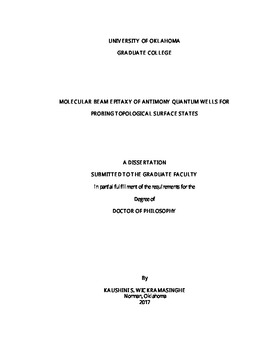| dc.description.abstract | A topoelectronic transition was predicted for an Sb quantum well (QW) as a function of QW thickness. Bulk Sb is a semimetal with a negative bandgap, with neither the conduction band minimum nor the valence band maximum at the Γ point. The Dirac point for the topological surface states is at the Γ point. In this dissertation, we present a detailed structural analysis of ultra-thin Sb QWs grown using a novel molecular beam epitaxy procedure that controls the thickness of the QW down to a few angstroms. Also, we studied the electronic properties of the topological surface states by suppressing the bulk conductivity through quantum confinement and enhancing the surface conductivity through remote n-type doping at the Γ point.
Conductivity measurements on undoped QWs (0.7 to 6 nm thick) show a suppression of the bulk states, such that the surface conductivity is ~20% of the total conductivity for a 3.8 nm-thick QW. Interpretation of Hall-effect measurements, which nominally indicate p-type conduction for undoped QWs, was complicated by the presence of both electrons and holes.
Therefore, we carried out experiments to populate the topological electron states by doping the GaSb barrier layer with tellurium (Te) atoms, creating donor states at the Γ point. At the Γ point of the QW, the topological electron states have a lower energy than any of the bulk conduction band minima. Remote n-doping of Sb QWs was confirmed by analyzing the spacer dependence of the Hall coefficients in a low magnetic field of 0 – 0.15 T and a temperature of 20 K.
From high field magnetoresistance measurements, we deduced that holes still contributed significantly to the conductivity even though the Hall voltage indicated nominally n-type conduction. By further analyzing the fine features in the longitudinal resistance, we deduced that the surface states in a remotely-doped QW have an electron concentration of ~3.3×1012 cm-2 and a mobility of ~1600 – 2000 cm2/V·s. Assuming the initial electron concentration, before doping the Sb QW, is 2×1012 cm-2 (i.e. the lowest possible value estimated from theory), we calculated that the maximum amount transferred to the QW is ~1.3×1012 cm-2 when using GaSb barrier material and a Te-doping concentration of 1×1018 cm-3. The fine features that we interpreted as Shubnikov de Haas oscillations are of the order of the noise level; thus we cannot be certain of this interpretation. Therefore, we suggest future experiments to resolve this uncertainty. | en_US |
